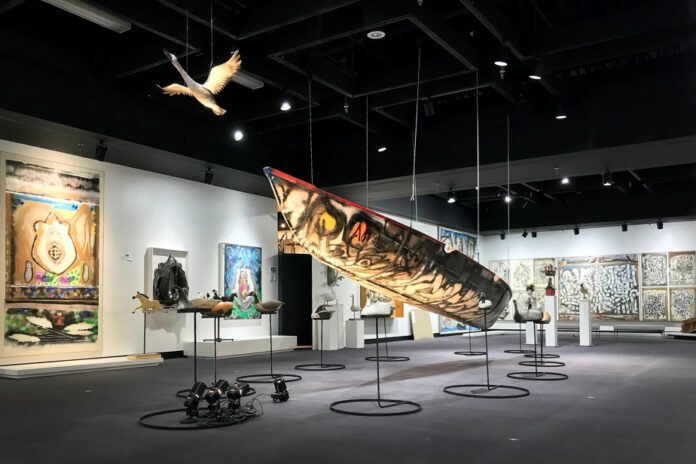“The concept for the exhibition came two years ago from Dr. Jean-Luc Dupuis, who made Jean Paul Riopelle’s film Les geese,” explains Sylvain Gendreau, director general of the Musée de Charlevoix. He asked us if we would be tempted to do something to mark the centenary of Riopelle’s birth. Then, Yseult, Riopelle’s eldest daughter, wanted to curate the exhibition she is dedicating to her father. »
“My idea was to link the museum’s collection to Riopelle, who was very fond of folk art,” says Yseult Riopelle. He often spoke of the Cheval postman, in France [a postman who built for 33 years, stone by stone, an ideal palace in the Drôme village of Hauterives]. And he used so many objects to make his works. A horse collar, horseshoes, snowshoes. He liked the shapes of everyday objects. »
With an accompaniment of sounds of nature, Riopelle and popular art – Objects found, diverted, stolen also evokes this love of biological diversity that marked Riopelle’s work. His attraction to animals, hunting and fishing is embodied in some twenty works belonging to members of the Riopelle family (including his youngest daughter Sylvie, who died last month) and to private collectors, coupled with dozens of arts and crafts from Quebec and elsewhere.
The exhibition begins with a section devoted to fishing. With wooden sculptures of fish and, in a display case, fishing flies by Paul Marier, Riopelle’s friend and fly-fishing ace. The fly entitled Riopelle has even been reproduced in large size by the artist Daniel Bernier.
Confronted with these handicrafts, one feels a kind of closeness. The works were arranged by Yseult Riopelle, assisted by Nadyne Deschênes, museology technician, integrating them into about ten sections. In the center of the main room of the exhibition, the ice canoe painted by Riopelle in 1990 is suspended. With an inclination that evokes the legend of the Chasse-galerie, and surrounded by wooden geese, one of which is taking flight.
By touring the great paintings of Riopelle, we become aware once again of the formidable construction of his pictorial gesture, of this accumulation of techniques which make his style remain unique and unequalled. We can appreciate his collage techniques, the insertion of recycled elements, juxtaposed, in particular his paint tube caps to represent the eyes of the geese, in Au pays des ouaouarons. And this way he had of defining an animal form by applying the color directly with the tube.
One area evokes the snowshoes he used on his feet young and as a stencil later on! Another zone is that of the roosters, with in particular the installation À voleur vol by Madeleine Arbor who, moreover, turned 100 on March 3. Roosters that these two great friends enjoyed stealing from crossroads and weather vanes! In the name of the Rooster Thieves Club! The scoundrels!
On the mezzanine hung 13 prints from the Cap Tourmente series, works from the museum’s collection. In the hall are installed sculptures. Excerpts from the film Les oies by Jean Paul Riopelle are projected in an adjacent room, where the studio that Riopelle had in Cap-Tourmente has been reconstructed in a certain way. Screenings of the film will be organized on Fridays and Saturdays at 1:30 p.m. so that it can be viewed in full. Note that this film will be presented at Domaine Forget, in Saint-Irénée, on June 18 at 2 p.m.
At the same time, the Musée d’art contemporain de Baie-Saint-Paul is offering, from June 17 to November 5, A place of memories: contexts of existence, which the Musée d’art de Joliette presented until May 14. . An exhibition curated by the Italo-Danish Irene Campolmi and which includes paintings, bronzes and collages by Riopelle as well as works by five foreign artists. In Baie-Saint-Paul, the deployment of Irene Campolmi is accompanied by two other works by Riopelle, large formats, one of which belongs to his last companion, Huguette Vachon. Note that the museum is also presenting Couleurs en jeu, an exhibition of works by Jean McEwen, whose centenary is also being celebrated this year. “Works by Françoise Sullivan will also be added to the entrance of the museum,” said Gabrielle Bouchard, director general and chief curator of the museum. A tribute to Françoise Sullivan since she too is a centenarian. She turns 100 today!















